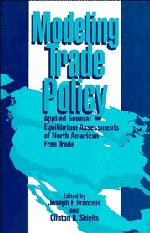Book contents
- Frontmatter
- Contents
- List of Contributors
- Dedication
- Part I Introduction
- Part II Multisector Models
- 2 A General Equilibrium Analysis of North American Economic Integration
- 3 The Gains for Mexico from a North American Free Trade Agreement – An Applied General Equilibrium Assessment
- 4 Some Applied General Equilibrium Estimates of the Impact of a North American Free Trade Agreement on Canada
- 5 Properties of Applied General Equilibrium Trade Models with Monopolistic Competition and Foreign Direct Investment
- Part III Sector-Focused Models
- Part IV Dynamic Models
- Index
2 - A General Equilibrium Analysis of North American Economic Integration
Published online by Cambridge University Press: 25 March 2010
- Frontmatter
- Contents
- List of Contributors
- Dedication
- Part I Introduction
- Part II Multisector Models
- 2 A General Equilibrium Analysis of North American Economic Integration
- 3 The Gains for Mexico from a North American Free Trade Agreement – An Applied General Equilibrium Assessment
- 4 Some Applied General Equilibrium Estimates of the Impact of a North American Free Trade Agreement on Canada
- 5 Properties of Applied General Equilibrium Trade Models with Monopolistic Competition and Foreign Direct Investment
- Part III Sector-Focused Models
- Part IV Dynamic Models
- Index
Summary
Introduction
The North American Free Trade Agreement (NAFTA) is representative of a worldwide trend toward regionalism in trade negotiations. This shift away from multilateralism is a result of both the strengths and weaknesses of the GATT framework. On one hand, GATT has been quite successful at demonstrating once and for all that relatively low tariff protection can greatly expand global trade opportunities. At the same time, however, these norms have lowered the stakes for regionalists, who can now remove residual protection with their neighbors secure in the knowledge that severe retaliation is not individually rational for other trading partners. The success of GATT in reducing average tariff protection has also narrowed the negotiating agenda down to its more stubborn elements, such as trade in agricultural and textile products.
GATT's weaknesses have also become more apparent and problematic over time. In its early days, the multilateral negotiating framework faced a relatively easy task, with a few dominant economies leading the way by leveling tariff barriers on a dominant share of international trade. Now the family of influential traders is much larger, their geographic and economic interests are more diverse, and consensus is much more difficult to achieve or even approximate. Finally, an emphasis on multilateral negotiations on tariff protection has led to proliferation of nontariff trade control measures that in many instances threaten to reverse the long-term trend toward a more liberalized global trading regime.
- Type
- Chapter
- Information
- Modeling Trade PolicyApplied General Equilibrium Assessments of North American Free Trade, pp. 47 - 82Publisher: Cambridge University PressPrint publication year: 1994
- 3
- Cited by



